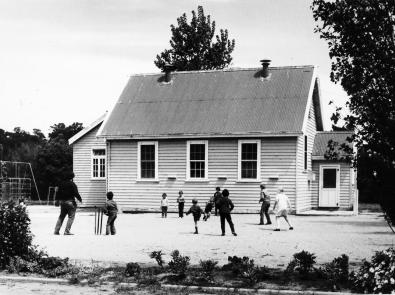The now-abandoned township of Cocoroc was built in 1894 at the Werribee Sewage Farm (now the Western Treatment Plant) to house its workers. But there are still many fascinating stories – if you know where to look.
Did you know? ‘Cocoroc’ means ‘frog’ in the language of the Wathaurung people, the Traditional Owners of the land.
Rise and fall of Cocoroc
Despite housing some 500 people, Cocoroc was abandoned as it became too expensive to subsidise for the Melbourne and Metropolitan Board of Works (MMBW). By 1973, most buildings had been demolished or moved to Werribee. All that now remains are two empty swimming pools, a sports pavillion, town hall and heritage-listed water tank.
- 1894: A plan of the township shows 72 allotments, a landscaped park and six cottages.
- 1895: The first of the farm’s four state schools opens.
- 1897: The town grew to include 32 houses.
- 1903: The town hall was built, becoming the hub of the community.
- 1940s: The farm had its own pool, sports pavilion and oval, tennis court, church and post office.
- 1944: The farm’s houses were connected to electricity.
- 1950s: The township reached its peak, with nearly 100 houses.
- 1970s: About 500 people were living in Cocoroc.
Life in the township
For many residents, Cocoroc offered more than just lodging: it was a thriving community and source of identity and pride.
Working at the farm
Earning a day’s pay wasn’t easy for employees. Farm work was very physically demanding, mostly carried out by teams of horses drawing ploughs and scoops. But the Farm did own one piece of prized machinery: its Caterpillar.
Even children had jobs, collecting wood or milking cows before and after school. This meant a long day!
By the mid-1950s, the introduction of lagoon treatment and mechanisation revolutionised work – and ended the days of the draft horses.
A close-knit community
The town was self-sufficient, and workers were well provided for. Their rent provided half an acre of land – enough for a vegetable garden, chook pens, a pig or two, plus the two milking cows the MMBW gave to each family. Annual prizes were awarded for the best garden, and scholarships for children aiming to go to Werribee High and technical schools.
Cocoroc’s first school opened in 1895, employing many teachers throughout its 77-year history. The school hall hosted dances, and its committees organised the end-of-year party and annual picnics to raise funds for school equipment.
Such community events were commonplace.
Not just a job
Living and working on a sewage farm created some stigma for residents and their sporting teams. But they turned these negative sentiments into a source of solidarity and local pride – exemplified by their football team, the Herefords, named after the farm’s cattle.
Sport was a central part of town life. Among the facilities the township eventually boasted were a:
- swimming pool
- sports pavillion
- oval with goal posts for football and cricket pitch
- tennis court.
Generations on the farm
Cocoroc represented secure employment, often when work was hard to come by. It became interwoven with some families’ histories, with multiple generations finding themselves on the MMBW payroll.
Some of the jobs men performed were:
- fencing and carpentry
- stablemen, watermen and stockmen
- tractor drivers
- nursery workers.
Women also made a valuable contribution to the farm’s daily activities as housewives, mothers, secretaries and cleaners.
Today, some of these families remain locals of Werribee.
Key places
The following structures are some of the few that remain standing at Cocoroc today. To explore them in 360 degrees, why not take our Western Treatment Plant virtual tour?
Town hall
The Cocoroc Town Hall may have been the town’s most important place. It was a library and a mainstay of residents’ weekly entertainment, hosting:
- Saturday night dances
- Monday night euchre (a card game)
- the annual school concert
- wedding receptions and other parties.
Originally built in 1903, it burned down in 1924 but was rebuilt and moved to its current location in 1975.
The historic water tower
Erected at East Melbourne in 1854, the heritage-listed tower originally stored water pumped from the Yarra River. In 1892 it was dismantled and moved to Cocoroc to provide a back-up water supply at a cost of £1,128. It was decommissioned in 1925 after the town was connected to mains water, and finally drained in 1929.
For many years, soil from the farm’s tree nursery was stored beneath the tank. But an extensive restoration project gave it a new lease on life – as an interpretive centre housing displaying the site’s rich history.
Follow our Online Community Hub to stay up-to-date with the latest news on our Western Treatment Plant:
You may also like...
Follow our online community hub and be the first to know about new projects, ways to visit and opportunities to help shape the future of the site.







